Recent Posts
10 Iconic Kitchen Knife Brands Worth Adding to Your Collection
Finding The Best Kitchen Knife Brands
Whether you’re a timid home cook in training or a nimble knife-wielding pro, you can accomplish a lot in the kitchen with the right tools. Dull knives create mess, slow down preparation, and, believe it or not, can diminish the taste and enjoyment of the finished product.
Not only do we introduce you to some of the highest quality knives on the market, but we’ve also compiled a list of the best kitchen knife brands to give you more knowledge about the world of knives and help you improve your overall cooking experience.
After introducing you to some of the best brands on the market, we’ll tell you what to look for when buying a knife. We’ll also give you basic information about the most common knife types.
But first, let’s look at why you should choose a high-quality kitchen knife and what importance it has for your culinary journey.
Why You Need the Best Kitchen Knives
Regardless of whether you’ve ever stepped into a kitchen to prepare a meal, chances are you’ve come face to face with a knife, or rather, found yourself staring at the blade, that simply didn’t serve its purpose.
Maybe you had trouble cutting a crusty loaf of bread with a straight blade, or your steak was smashed with a regular table knife. Whatever the reason, you may know how important the right knife is, but have no idea how important quality is.
The art of cooking at home is more popular than ever, and more and more people are realizing the difference a quality knife makes when cooking—whether for themselves or for a group of family and friends.
The right knives help speed up work, make it easier, and allow you to experiment with different cooking styles. They have a profound impact on what and how you eat.
Twenty years ago, quality knives were reserved only for professional chefs. Today, anyone can own one and act like a pro in their own kitchen.
10 Best Kitchen Knife Brands
Below you’ll find our top 10 best kitchen knife brands on the market. We’ve made sure to cover a wide range of brands, so pay attention to what makes each one unique.
1. Our Place Everyday Chef’s Knife
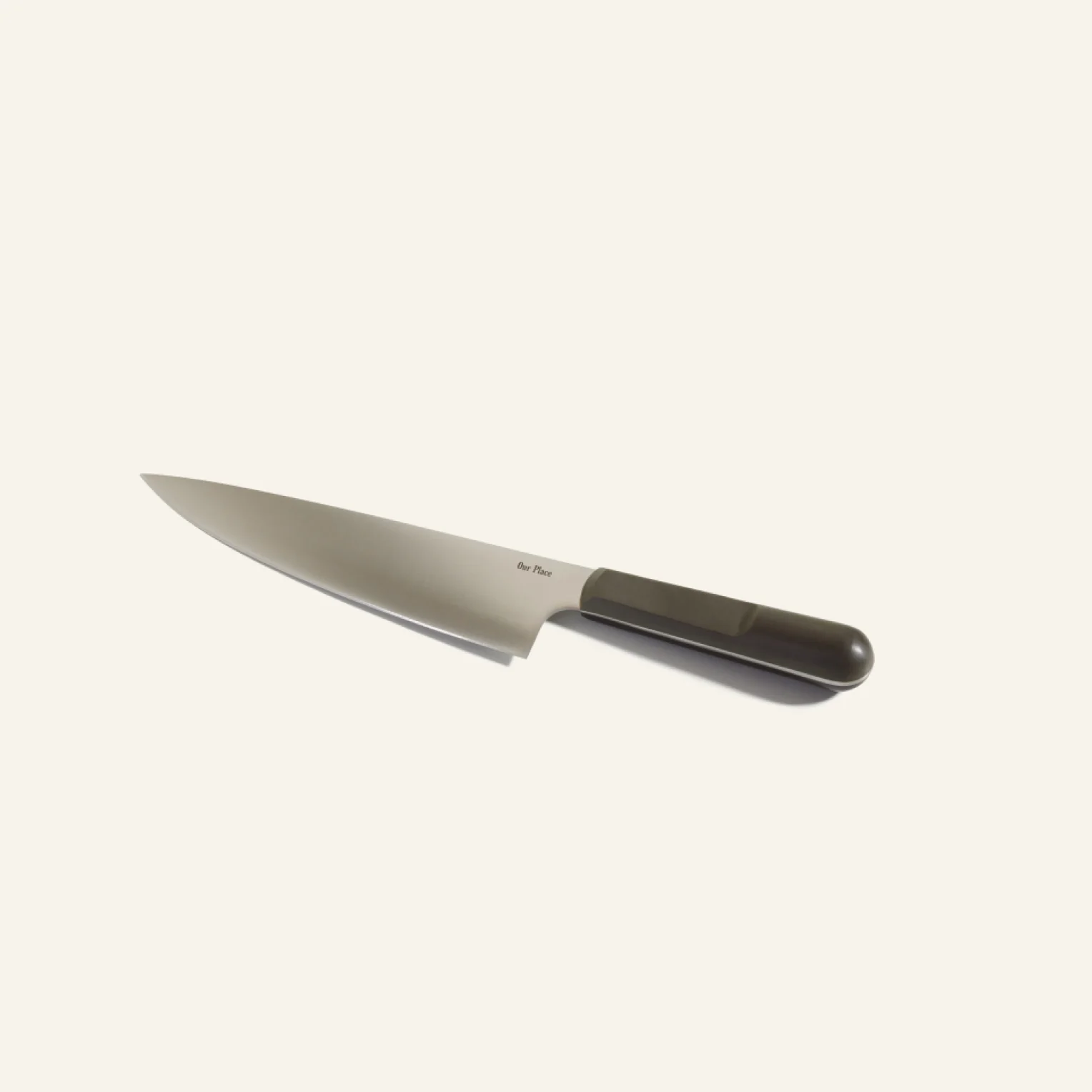
The Our Place chef’s knife is a culinary masterpiece that will revolutionize the way you chop, slice, and dice in the kitchen. Crafted with precision and passion, this knife is the ultimate tool for any home cook, combining cutting-edge technology with timeless craftsmanship.
The chef’s knife is designed to the highest quality and features a razor-sharp blade made of premium German stainless steel, ensuring unparalleled sharpness and durability. The ergonomic handle fits comfortably and securely in the hand, allowing effortless maneuvering and precise control with every cut.
Whether delicate herbs, savory vegetables, or succulent meat, this versatile knife glides effortlessly through ingredients and delivers flawless performance. From meal prep to gourmet cooking, it’s the perfect companion for all your culinary adventures.
Expand your cooking experience and unleash your inner chef with the Our Place chef’s knife. With its unparalleled quality, performance, and style, it’s sure to become an essential part of your kitchen arsenal.
2. MAC Knives
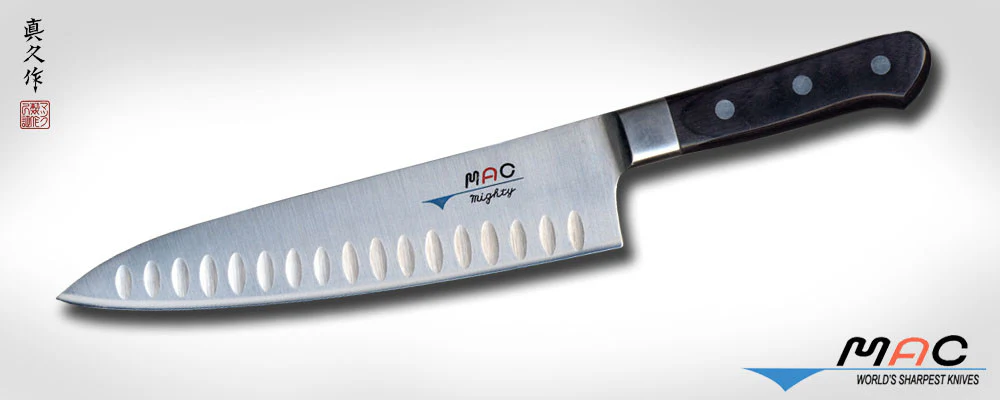
MAC Knives is a brand steeped in Japanese heritage that has evolved into a popular Western brand name. Founded in 1965 by Tatsuo Kobayashi, the brand is recognized for its professional appearance and outstanding craftsmanship.
With over 25 million knives sold, MAC Knives has pursued the mission of “making better, sharper, lighter, and more comfortable knives” for over 50 years. The collection includes Western-inspired Japanese blades, as well as sharpeners and accessories like cutting boards.
MAC Knives’ Western-style blades have a Rockwell hardness of 58-60, but the brand offers numerous other series, from traditional Japanese blades to Damascus steel blades. The blades are entirely handcrafted from grinding to sharpening and promise razor-sharp edges that stay sharp longer than other brands.
These claims are confirmed by customers and publications like the New York Times, who describe the blades as maneuverable, comfortable, and extremely sharp. Should your blade ever fail, you’ll receive a 25-year warranty against defects in materials and workmanship.
3. J.A. Henckels
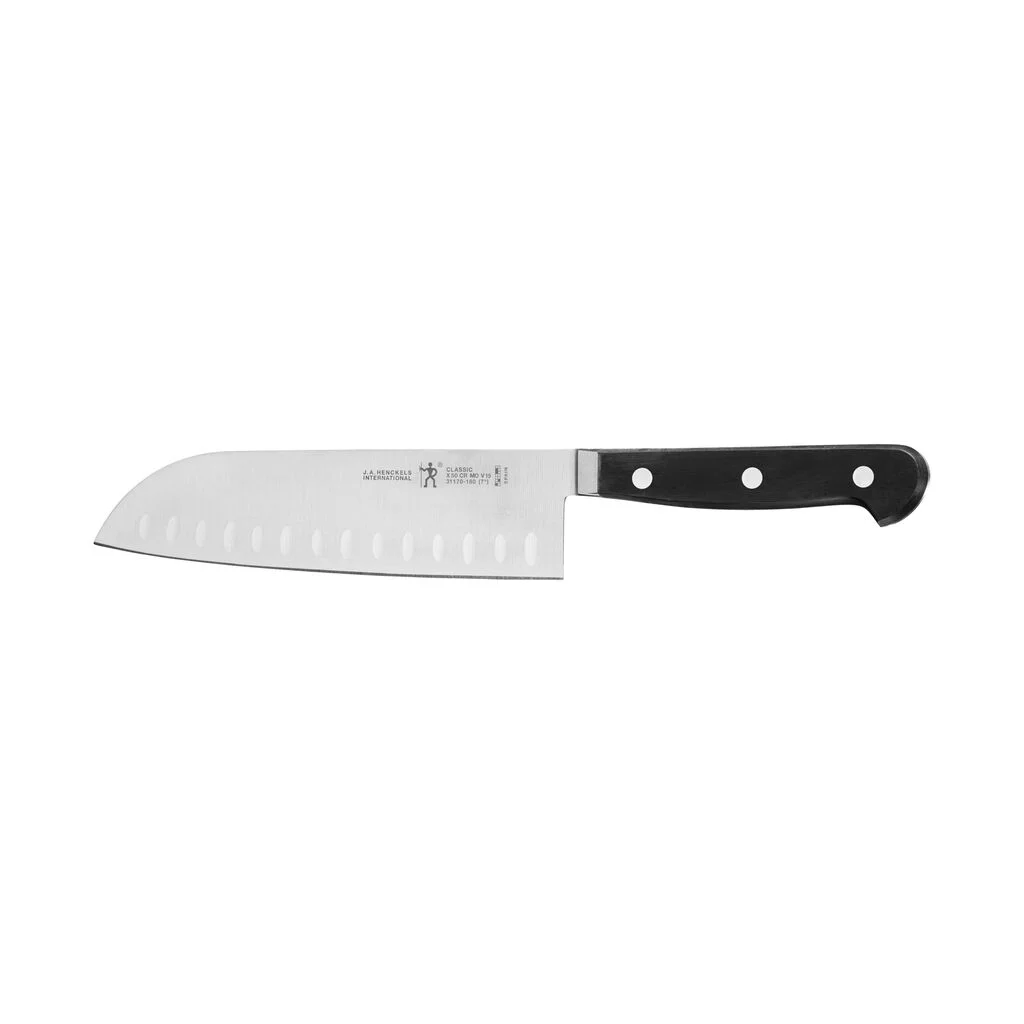
J.A. Henckels is probably one of the most popular companies on this list of the best kitchen knife brands, producing high-quality German knives that are valued worldwide. The knife brand, which founded the Zwilling brand in 1731, has been forging blades from high-carbon stainless steel since its inception.
Over the years, J.A. Henckels has evolved into an umbrella organization for brands like Staub, Ballerini, and several other well-known names. Although the company specializes in knives, its product range also includes cutlery, cookware, electrical appliances, and even tableware.
It is considered an affordable brand with sharp edges and comfortable handles, offering quality products at affordable prices.
The brand offers a wide selection of blades, including ice-hardened and one-piece forged blades. Buyers can enjoy a wide variety of styles, from bread and paring knives to chef’s knives.
All J.A. Henckels knives are made in Germany, receive high star ratings from customers on Amazon, and come with a lifetime warranty against defects and workmanship.
4. Misono
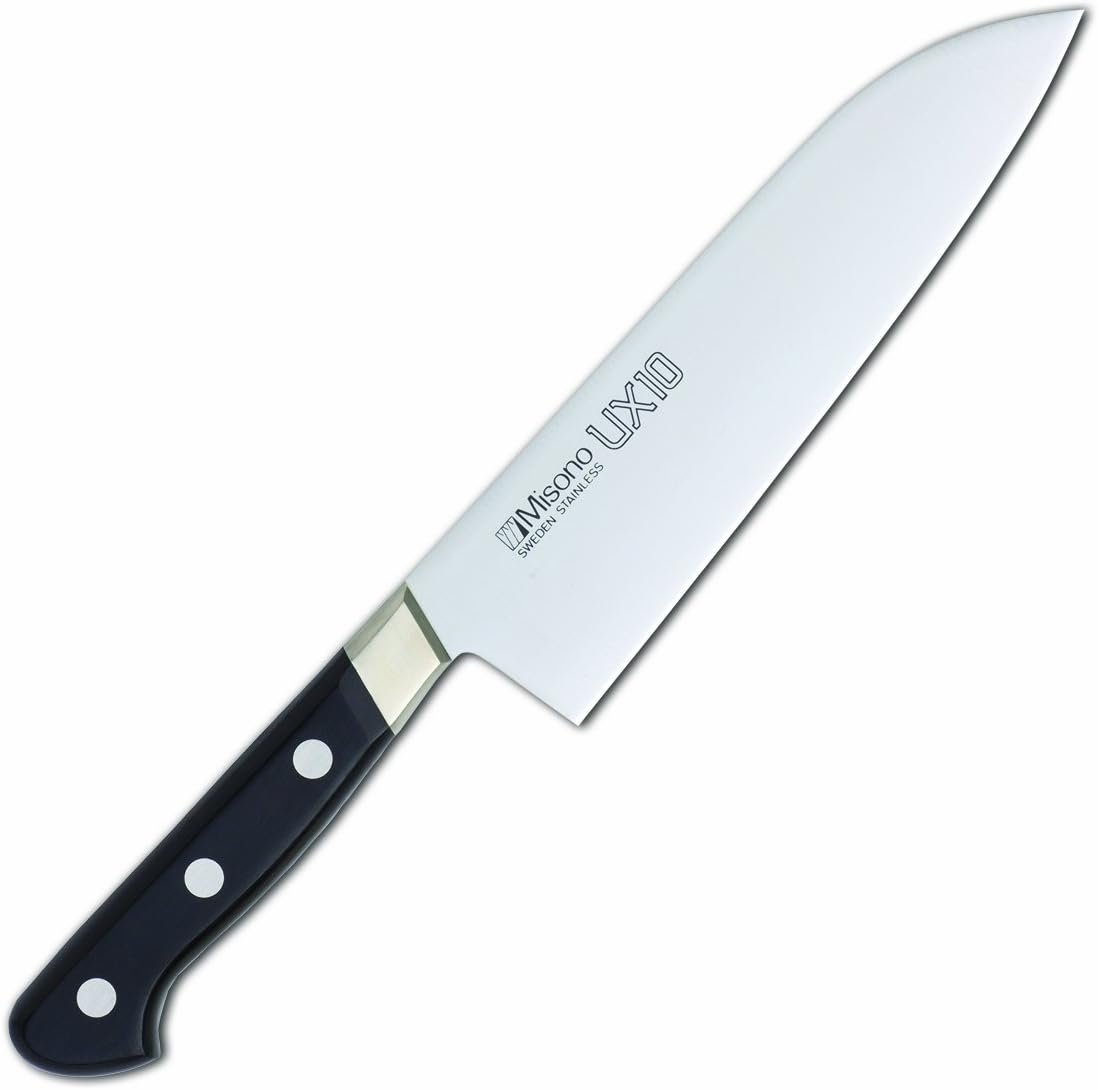
If you value the familiarity and reliability of small businesses, you should try Misono. Founded in Japan in 1935, this family-owned brand initially specialized in vegetable peelers.
The brand is Japan’s oldest manufacturer of Western knives. With just 50 employees, Misono produces 150,000 knives annually. Misono focuses on “long-lasting edge retention for professional use” through hard steel and handcrafted finishes.
The brand offers knives and accessories for Japanese cuisine, such as sushi and ramen, and produces only seven types of knives with several variations and sizes per category.
Misono’s collections include all common Western knife styles, including chef’s knives, paring knives, and santoku knives. All knives are crafted from either molybdenum steel or Swedish carbon steel, but feature Japanese touches that give them a sleek, professional look.
Overall, users rate the knives 5/5 stars, reporting that they are extremely sharp and well-balanced right out of the box. Prices are quite affordable—an 8-inch carbon steel blade costs $130.
We have not found any warranty information on the brand’s website or elsewhere.
5. Shun
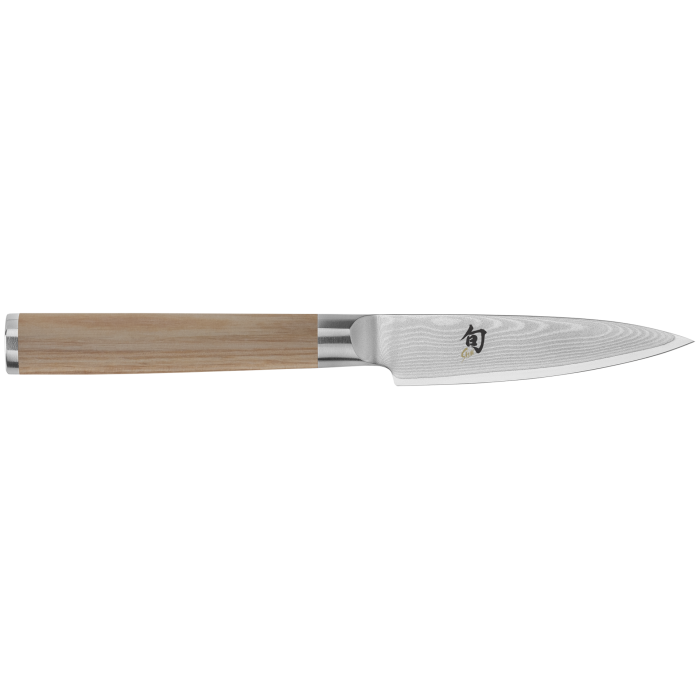
Shun knives are part of the Kai Group. The brand was founded in 1908 by Saijiro Endo in Seki, Japan, and began producing various cutlery sets for the Asian market. In 2002, they were also introduced to the Western market.
Shun believes that “the blade is more than a tool; it is a tradition.” Whether a samurai sword or a steak knife, a blade is something to be admired and requires thought and high-quality craftsmanship.
Shun’s mission is to “preserve ancient traditions by continuing to handcraft each knife in our factories in Seki City—the birthplace of Japanese knifemaking.” Each piece of the brand’s cutlery undergoes over 100 steps to preserve tradition and honor the craft.
The brand has received numerous awards for several of its knives, demonstrating their high quality. The brand, which specializes in blades, offers a small collection of knives, sets, and matching accessories such as cutting boards.
Since the brand offers several blade series, we decided to take a closer look at the Dual Core series to get some specifications on materials and features.
These knives are made of VG10 steel and are described as “a complex blend” of chromium, manganese, molybdenum, silicon, and vanadium. These blades are incredibly strong and come with a lifetime warranty.
On the website, most products have a rating of 4.5–5/5 stars, and customers generally say that Shun is a respected brand and one of the best in the world.
6. Mercer Culinary
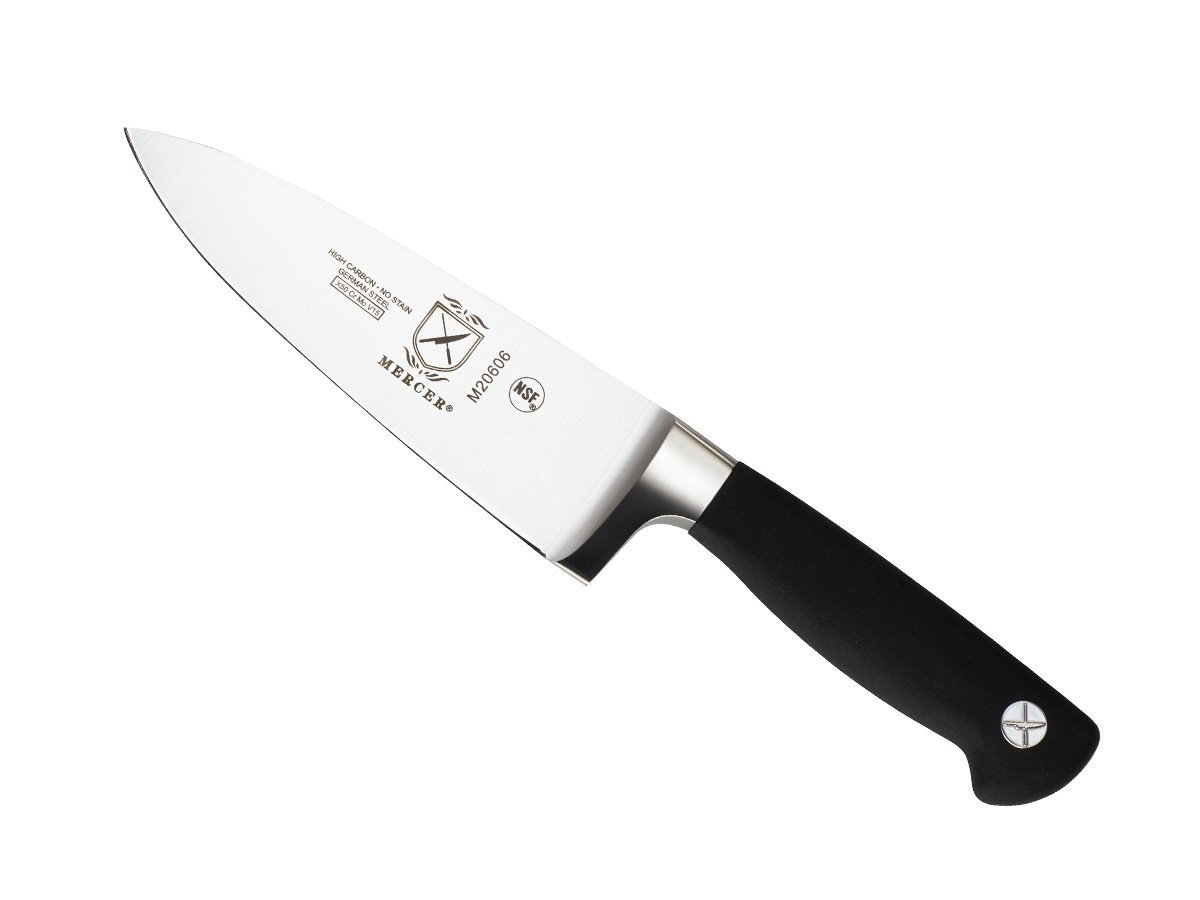
Mercer Culinary, specifically designed for the hospitality industry, is a performance-oriented brand known for its superior craftsmanship and long-lasting products, serving professional chefs, bartenders, and all other industries.
Founded by Jim Wallick, Mercer’s mission is to “make your work more enjoyable, easier, and more efficient.” As we’re putting together a list of the best kitchen knife brands, we found that the knife selection includes a variety of collections, such as Renaissance, Genesis, Millenia, and more. The aesthetics of this brand are particularly noteworthy.
Compared to other companies on this list, Mercer offers the widest selection of designs and colors. Choose the all-white collection to complement a cream-colored kitchen, or add a little pop of color to spice things up.
Since each of the knife collections is so diverse, we decided to take a closer look at the Renaissance line to find out what makes it so special.
The Mercer Renaissance knives are made of high-carbon German steel, are rust- and corrosion-resistant, triple-riveted, and feature excellent balance. The Millenia collection is inspired by Japanese knives and offers an extremely sharp edge and is easy to sharpen.
Customers rate Mercer knives highly, highlighting their sharpness and excellent cutting ability.
The brand’s collections come with a lifetime warranty that covers defects in materials and workmanship under normal use.
7. Imarku
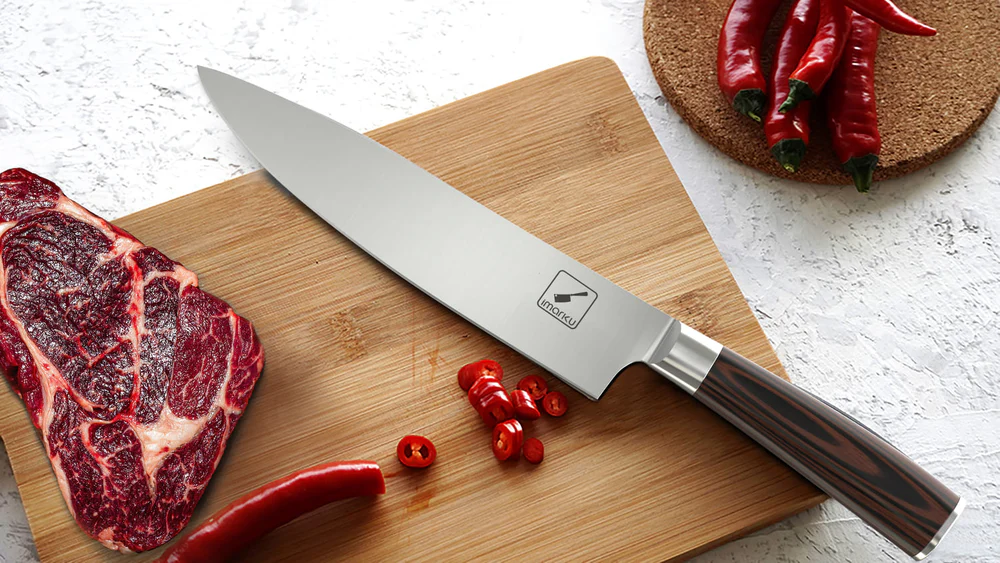
Imarku was developed for professionals and first appeared in the restaurant industry about 13 years ago. There’s another brand called Imarku with a longer history, founded in Germany. The brand we feature in this list of the best kitchen knife brands was founded by Mark Liu. We couldn’t find out exactly where, but it appears to be in the USA.
The knives, made from German high-carbon 7cr17mov steel, take over 45 days to produce, although the style is reminiscent of Japanese steel, where Liu trained. The brand says it uses this steel because it contains twice as much carbon as other steels and offers incredible balance.
Imarku’s product range includes professional chef’s knives, steak knives, and Japanese knives, but you can also find cookware on the website.
The range of knives includes all popular styles, including butcher knives, sushi knives, boning knives, and more. And you can purchase sets of 4 to 16 pieces for your professional collection.
The brand uses a variety of handle styles, some ergonomic, some made of beautiful pakkawood. Imarku knives are said to be balanced, durable, and sharp, as well as thick, sturdy, and affordable—the 8-inch chef’s knife ($40) received 4.7 out of 5 stars from over 7,800 customers on Amazon.
8. Wüsthof
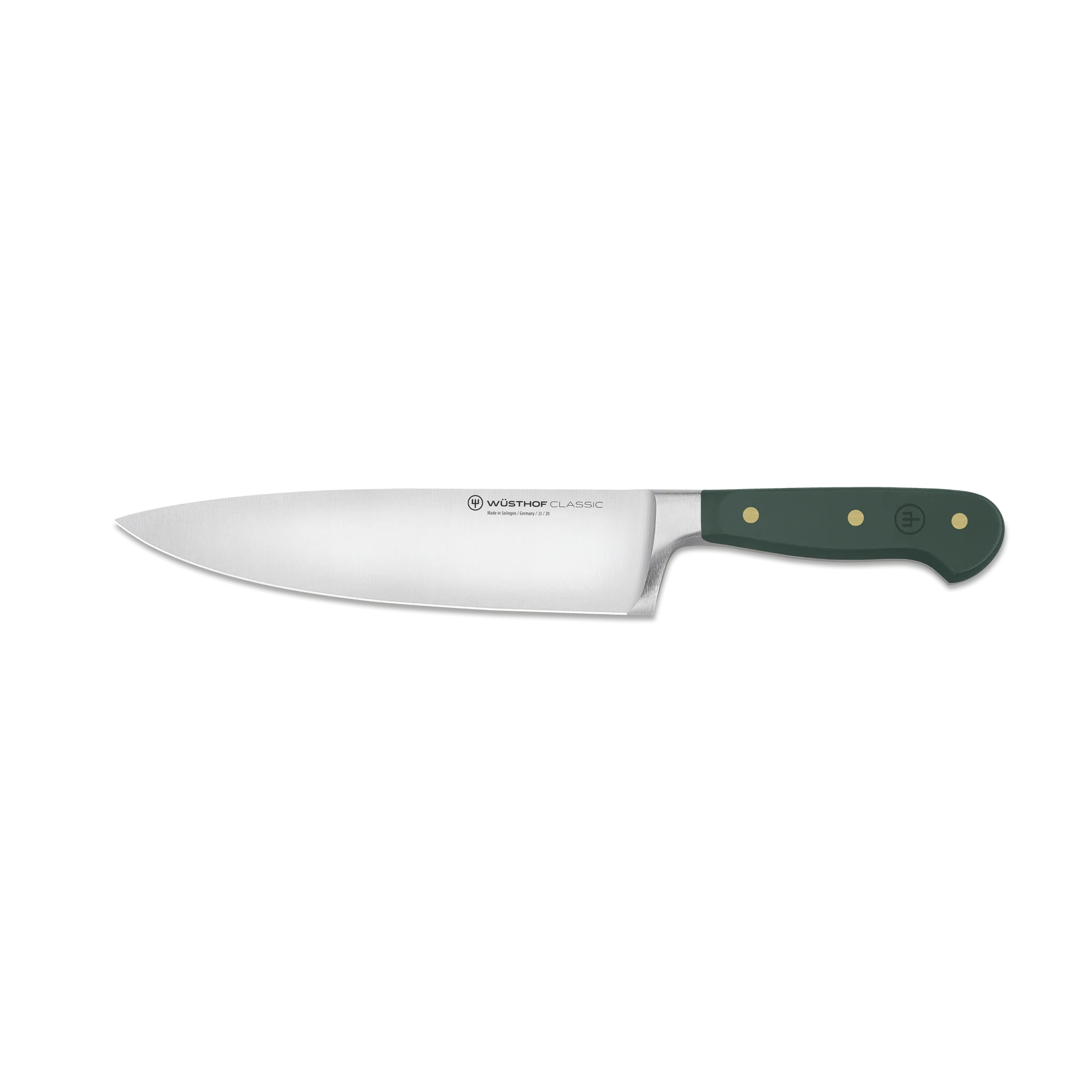
Wüsthof was founded in 1814 in Germany, specifically in Solingen, if the name doesn’t suggest otherwise. Wüsthof family knives have been manufactured in the same location for generations—in the world capital of steel production.
Knives with the “Made in Solingen” seal of quality are incredibly valuable and are considered some of the best in the world.
Wüsthof offers hundreds of knife variations in the chef’s knife and carving knife categories. Within these categories, you’ll find many different handle and blade styles, some with serrated edges, others with straight edges. You can search by style. So if you’re looking for a specific color for your kitchen, you can select it and purchase that look.
Wüsthof knives are mid-priced, but the company is known for its excellent offerings. On sale, the knives cost around $150. The brand also offers a specialty knife section. We’ll show you what they’re made of.
The Wustoff specialty knives are made of chrome-molybdenum-vanadium steel and have a blade hardness of 58 and a surface hardness of 104 Rockwell. The blades’ handles are made of 3,249-year-old bog oak with a diamond-like carbon coating (they even come with a certificate of authenticity).
For the brand’s other knives, the cutting edge is computer-shaped using a precision laser. The desired result is achieved in 14 steps. The laser ensures that the knives are 20% sharper than conventional knives and the blade lasts twice as long.
Laser-cut blades are made from high-carbon stainless steel and are more affordable than Wüsthof’s forged knives, which are manufactured in 40 steps.
The brand is backed by a lifetime guarantee, and the general perception is that it truly delivers on its promises—they stay sharp, are balanced, sharp, and elegant. Even Gordon Ramsey uses them in his online cooking class.
9. Tojiro
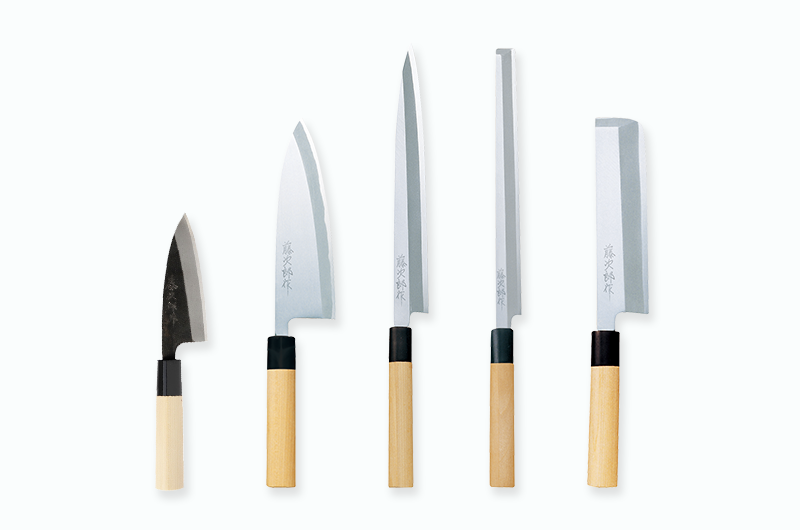
Tojiro is manufactured in Tsubame-Sanjo, Japan, and specializes in extremely sharp blades. The brand is guided by four principles: loyalty, sincerity, appreciation, and creativity.
Founded in 1953 by Susumu Fujita, the company initially manufactured agricultural machinery, producing machine parts and tractor blades. Just two years later, it began producing cutlery—and fortunately, because today the company is popular with professional and amateur chefs around the world.
Since sharpness is the most important aspect of a chef’s knife, Tojiro selects only the finest raw materials for his blades. The team then incorporates their expertise and the family’s traditional blademaking technique.
In the collections you will find beautiful knives in Western, Japanese and Chinese style with over 400 styles and sizes within these categories.
With blades made of VG10, molybdenum, high-speed steel, nickel damascus, and other materials, you have a wide selection to meet your personal preferences in terms of hardness and design.
The handles are available in metal, wood, or resin. We particularly like that the brand’s website offers buyers the option to search by material or series. While searching is possible, purchasing isn’t possible on the website. However, the knives are available on Amazon or in specialty cooking stores.
Speaking of Amazon, we looked at the reviews for the DP Gyutou knife and received a 4.7/5 star rating from 192 buyers. And no matter where you buy your Tojiro, you get a lifetime warranty.
10. Victorinox

Victorinox, the original inventor of the Swiss Army knife, is a Swiss brand founded in 1884. Over the years, the brand has adapted to a specific lifestyle, expanding its collection of high-quality knives to include watches, luggage, and fragrances.
The brand offers a wide range of blades and assures its customers that each blade has a different strength, but all guarantee top performance. The brand makes its knives from stainless steel, which, according to BBC Good Food, is not usually the best choice for sharpness—except for Victorinox knives.
Although you can slice peppers with a Swiss Army knife, we’re focusing here on the best kitchen knife brands. The extensive selection includes over 60 knives in the chef’s knife category alone, plus hundreds more in categories like santoku, bread knives, and paring knives.
Unlike most of the other brands on this list, you can’t buy Victorinox knives directly from the website. Instead, you have to search for retailers who do. According to over 11,000 customers who have purchased a specific model from the brand, it’s near-perfect, very sharp, and of high quality.
We couldn’t find any warranty information for their knives on the brand’s website, but we did find a lifetime warranty for the Swiss Army knives.
How to Choose the Best Kitchen Knife Brand
Like so many things in this world, choosing a kitchen knife is a personal matter. Every material, style, and length has its advantages and disadvantages. Therefore, it’s important to know your needs before shopping.
The most popular kitchen knives are generally German and Japanese. You may have noticed that the brands we’ve featured in this list of the best kitchen knife brands generally offer either one or the other, although some carry both.
In this section, we’ll tell you what you can expect in terms of material, blade, and edge of both the German and Japanese versions, as well as some other details that might influence your decision.
German Knives
German knives are characterized by their heavier weight and thicker blades. They typically have a more rounded edge, are suitable for cradling, and are valued by chefs for their versatility in the kitchen.
They can withstand the pressure of difficult tasks, such as butchering a whole chicken or cutting a ribbon, but also more delicate tasks such as dicing herbs.
German knives have a 20-22 degree angle and weigh an average of about 250 g for a length of 20 cm, thanks to the thicker blade and heavy bolster. In terms of construction, these blades are softer—approximately 56-58 on the Rockwell scale.
Lengths vary, but the most common German knife is about 20 cm long.
Japanese Knives
Japanese knives are precise and have an acute angle of 12–15 degrees. They are incredibly lightweight and known for their thin construction and bolster-free design. Weighing approximately 150 g (8 inches), Japanese blades are hard (approximately 60–61 on the Rockwell scale) and are prized for their long durability between sharpenings.
However, this hardness can also lead to more frequent chipping. Therefore, handle your blade carefully. You will need a whetstone to sharpen your Japanese blade. Since these blades have an edge on only one side, you need to use a special technique.
Use your Japanese knife for work that requires precision. Avoid working with bones and leave that to your German friends.
Things to Consider When Shopping for the Best Kitchen Knives
Buying the best kitchen knives online can be difficult, but we hope this list helps. We’ll not only introduce you to some of the most popular brands, but also show you what to look for when choosing the right knife for your kitchen.
Just like food, knives are a personal matter, and if you’ve learned anything from this review of the best kitchen knife brands, it’s hopefully how different knife brands and types can be.
When choosing a knife that suits your preferences, needs, and tasks, it’s important to consider the material, the feel (balance), and the type of food you prepare in your kitchen. We’ll cover all of these topics in more detail below to help you better understand what to look for.
Blade Material & Features
There are countless knife materials available, but manufacturers typically choose materials that can withstand sustained use and pressure well. Certain knives made for specific purposes use specialized materials to handle the tasks they’re designed for. For example, a boning knife needs to be flexible, whereas a paring knife doesn’t.
The most common materials for knives are stainless steel or carbon steel. These materials are preferred for kitchen use, are generally less expensive, and are easy to use and clean.
You may come across ceramic chef’s knives or titanium cleavers, but ultimately these materials were chosen because they support the specific purpose of the knife in question.
Aside from the materials, some knives also feature indentations or holes, as well as extremely sharp or pointed tips. While holes reduce friction, pointed tips are ideal for piercing tough foods like meat and generally make the cutting process much easier.
Edge
The edge is the sharp point on the bottom of your knife, while the spine is the flat, blunt tip. You can safely press your hand against the spine of your knife, but you should never touch the edge.
Depending on the knife design, it can have a straight edge on one side (single edge) or on both sides (double edge). Certain designs, such as bread knives and steak knives, have a serrated edge that makes it easier to saw through tough materials.
In addition to the type of edge, certain knives can also have different degrees of sharpness to perform specific tasks. Cutting meat and bone requires an incredibly sharp edge, which is why high sharpness is one of the defining characteristics of a boning knife.
Forged vs Stamped
Knives can be either forged or stamped. Depending on who you talk to, some will say one is better than the other. Forging is the more traditional method of blademaking, while stamping is a more modern method.
If you’ve ever watched the hit TV series “Forged in Fire,” then you know how exhausting and hot it is to craft a single blade. If not, just know that it’s an art form that involves crafting a blade from a single piece of steel, which is then heated and hammered to shape and strengthen it.
Think of stamped knives like cookies. The knife shape is cut from a larger sheet of steel or other metal and then shaped and sharpened until the final product is created.
Forged knives are generally considered more robust, but their production is quite complex. Stamping allows for faster production and larger quantities. This allows the blades to be sold at lower prices, even though they are made of high-quality materials.
Weight, Balance & Control
Hold something in your hand. If one end is heavier than the other, the object will be pulled in that direction. Using an unbalanced object can result in heavy movement in a particular area.
Consider a hammer, for example. While no knife will ever be as balanced as a hammer, you can imagine that the cutting motion will be disrupted if one end is heavier than the other (e.g., the handle).
A high-quality knife is characterized by a perfect balance between blade and handle, allowing for consistent cutting or chopping. The balance of your knife is influenced by several factors, one of the most important being the tang. The tang is the point around which the knife’s handle wraps. For consistent balance, it is important to shape this tang perfectly.
Another, lesser-known factor that influences your knife’s balance is distal taper. This fancy-sounding name simply refers to the thinning of the blade from tip to base.
And last but not least, there’s the bolster. The bolster gives your knife its stability, but it also needs to be the ideal weight to ensure balance.
Handle
While the appearance of the handle can be crucial in choosing a particular knife, the material and craftsmanship should be paramount. As you read through this list of the best kitchen knives, look for handles that fit comfortably in your hand or are made of durable materials.
Depending on the material, the knife will hold in a certain way. Some are curved to fit your hand, while others are smooth—which you choose is usually a matter of preference.
Handles were traditionally made of bone or wood, but today they are available in a variety of materials, including carbon fiber, titanium, fiberglass, and even plastic. The material your knife’s handle is made of largely determines the price and weight of the entire item.
For example, bone would be more expensive and heavier than a knife with a plastic handle.
Common Types of Kitchen Knives
Food textures vary enormously. Just as you wouldn’t use a butter knife to cut a steak, the knives used for preparing vegetables, starches, and meat are specifically crafted to properly handle each ingredient.
Whether for cutting, chopping or sawing: knives have different types of cutting edges, are made of special materials and have specific lengths.
Now that you’ve read our recommendations for the best kitchen knife brands, we’ve put together some more information on the most common types of kitchen knives to help you decide which ones you’d like to incorporate into your own kitchen.
Chef Knife
Have you ever seen a professional chef zipping through a pile of herbs or julienne a bunch of colorful bell peppers? They were probably using a chef’s knife. With its curved edge, it’s designed for slicing vegetables.
Chef’s knives can be made from a variety of materials—carbon steel, stainless steel, or ceramic. The knives are available in various sizes and can range in length from 15 cm to 35 cm.
Santoku Knife
Don’t let the name of this knife put you off. Although it’s a serious kitchen tool, many chefs find it incredibly useful in the kitchen. Translated from the Japanese phrase “Santoku bocho,” meaning “three knives,” this multipurpose prep tool is suitable for chopping, slicing, and dicing vegetables.
The Santoku knife, with its straight edge and narrow blade, is made of stainless steel, but is also available in carbon steel or ceramic. The blade is generally more robust than others, measuring approximately 15 cm, is durable, and is known to stay sharp longer.
Paring Knife
If you only cook occasionally at home, you might not be familiar with the paring knife. Nevertheless, it’s a useful tool for cooks of all levels—even those who only consider themselves master chefs. These 3- to 4-inch, non-serrated knives are suitable for chopping or slicing smaller tasks and are ideal for tasks that require a little more precision.
They are made of either forged steel or stainless steel, and experienced chefs recommend choosing a model with a handle made of resin or a durable material other than plastic, as these are prone to breakage due to the nature of the task being performed.
Bread Knife
If you’ve ever tried to cut a crusty loaf of bread with a steak knife, table knife, or chef’s knife, you know how important a good bread knife is. Measuring 20 to 28 centimeters long, it needs to be a few centimeters longer than the bread is wide to achieve a clean saw cut.
Bread knives almost always have a wide, serrated edge, making it easy to cut soft rolls and tough bagels, although a little sawing is required. These knives are made of carbon steel or stainless steel. The material isn’t that important, as they’re designed for soft foods.
Utility Knife
This particular type of knife is incredibly versatile. You can use it in the kitchen, then put it in your pocket and take it camping—provided it’s foldable.
In the home, utility knives are ideal for smaller jobs like chopping baby potatoes or cutting the string off a whole, tied chicken. The overall length is typically around 10 to 15 cm, and the material usually depends on the brand. Most knives use high-quality steel, and the harder edge geometry is specifically designed to ensure the blade resists chipping.
Boning Knife
The boning knife is another knife whose name is pretty self-explanatory. With its thin and flexible blade, it’s perfect for separating bones and meat, as well as easily cutting through ligaments and tough tissue.
This blade is approximately 5-6 inches long, known for its sharpness, and is useful in households where whole chickens or fish are commonly used.
Cleaver
A cleaver is what you imagine a psychopath to be using in their worst nightmares. At 25 to 30 centimeters long, it’s ideal for chopping hard objects (e.g., bones) and has been the knife of choice for butchers around the world for centuries.
Usually made of iron or carbon steel, this cleaver needs to be tough enough to withstand a lot of heavy work without the risk of breaking under the pressure, and sharp enough to cut through tough materials.
Many butchers also use the flat side as a meat tenderizer to tenderize meat. This makes it an incredibly versatile knife, indispensable for households where a lot of meat is eaten—and that meat is usually enjoyed on the bone.
Final Thoughts
We hope you’re now a little more informed about kitchen knives and know what to look for when buying. While these companies are our top 10 best kitchen knife brands, there are hundreds more on the market.
As you go through this list and decide which brand and style meets your needs and is suitable for your kitchen, pay attention to all the components mentioned here.
Ava Thompson
Ava Thompson is a lifestyle writer and wellness advocate with a passion for intentional living. With a background in mindfulness and sustainable practices, she explores brands that enrich everyday life—from self-care rituals and home organization to eco-friendly innovations. Ava believes that the best products aren’t just things; they’re tools for crafting a life you love.







Leave a comment